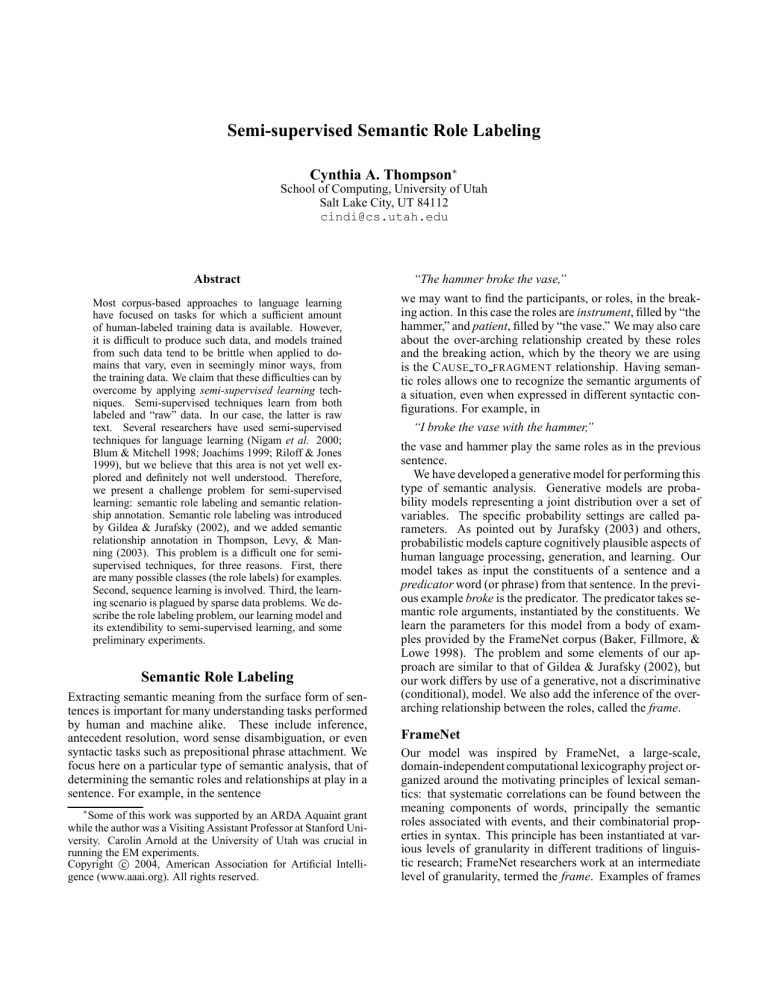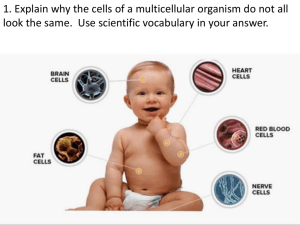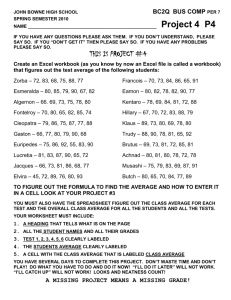
Semi-supervised Semantic Role Labeling
Cynthia A. Thompson∗
School of Computing, University of Utah
Salt Lake City, UT 84112
cindi@cs.utah.edu
Abstract
Most corpus-based approaches to language learning
have focused on tasks for which a sufficient amount
of human-labeled training data is available. However,
it is difficult to produce such data, and models trained
from such data tend to be brittle when applied to domains that vary, even in seemingly minor ways, from
the training data. We claim that these difficulties can by
overcome by applying semi-supervised learning techniques. Semi-supervised techniques learn from both
labeled and “raw” data. In our case, the latter is raw
text. Several researchers have used semi-supervised
techniques for language learning (Nigam et al. 2000;
Blum & Mitchell 1998; Joachims 1999; Riloff & Jones
1999), but we believe that this area is not yet well explored and definitely not well understood. Therefore,
we present a challenge problem for semi-supervised
learning: semantic role labeling and semantic relationship annotation. Semantic role labeling was introduced
by Gildea & Jurafsky (2002), and we added semantic
relationship annotation in Thompson, Levy, & Manning (2003). This problem is a difficult one for semisupervised techniques, for three reasons. First, there
are many possible classes (the role labels) for examples.
Second, sequence learning is involved. Third, the learning scenario is plagued by sparse data problems. We describe the role labeling problem, our learning model and
its extendibility to semi-supervised learning, and some
preliminary experiments.
Semantic Role Labeling
Extracting semantic meaning from the surface form of sentences is important for many understanding tasks performed
by human and machine alike. These include inference,
antecedent resolution, word sense disambiguation, or even
syntactic tasks such as prepositional phrase attachment. We
focus here on a particular type of semantic analysis, that of
determining the semantic roles and relationships at play in a
sentence. For example, in the sentence
∗
Some of this work was supported by an ARDA Aquaint grant
while the author was a Visiting Assistant Professor at Stanford University. Carolin Arnold at the University of Utah was crucial in
running the EM experiments.
Copyright c 2004, American Association for Artificial Intelligence (www.aaai.org). All rights reserved.
“The hammer broke the vase,”
we may want to find the participants, or roles, in the breaking action. In this case the roles are instrument, filled by “the
hammer,” and patient, filled by “the vase.” We may also care
about the over-arching relationship created by these roles
and the breaking action, which by the theory we are using
is the C AUSE TO FRAGMENT relationship. Having semantic roles allows one to recognize the semantic arguments of
a situation, even when expressed in different syntactic configurations. For example, in
“I broke the vase with the hammer,”
the vase and hammer play the same roles as in the previous
sentence.
We have developed a generative model for performing this
type of semantic analysis. Generative models are probability models representing a joint distribution over a set of
variables. The specific probability settings are called parameters. As pointed out by Jurafsky (2003) and others,
probabilistic models capture cognitively plausible aspects of
human language processing, generation, and learning. Our
model takes as input the constituents of a sentence and a
predicator word (or phrase) from that sentence. In the previous example broke is the predicator. The predicator takes semantic role arguments, instantiated by the constituents. We
learn the parameters for this model from a body of examples provided by the FrameNet corpus (Baker, Fillmore, &
Lowe 1998). The problem and some elements of our approach are similar to that of Gildea & Jurafsky (2002), but
our work differs by use of a generative, not a discriminative
(conditional), model. We also add the inference of the overarching relationship between the roles, called the frame.
FrameNet
Our model was inspired by FrameNet, a large-scale,
domain-independent computational lexicography project organized around the motivating principles of lexical semantics: that systematic correlations can be found between the
meaning components of words, principally the semantic
roles associated with events, and their combinatorial properties in syntax. This principle has been instantiated at various levels of granularity in different traditions of linguistic research; FrameNet researchers work at an intermediate
level of granularity, termed the frame. Examples of frames
include M OTION DIRECTIONAL, C ONVERSATION, J UDG MENT , and T RANSPORTATION . Frames consist of multiple
lexical units—items corresponding to a sense of a word. Examples for the M OTION DIRECTIONAL frame are drop and
plummet. Also associated with each frame is a set of semantic roles. Examples for the M OTION DIRECTIONAL frame
include the moving object, called the T HEME; the ultimate
destination, the G OAL; the S OURCE; and the PATH.
In addition to frame and role definitions, FrameNet has
produced a large number of role-annotations for sentences
that are drawn primarily from the British National Corpus. There are two releases of the corpus, FrameNet I and
FrameNet II. The corpus identifies a a lexical unit of interest, which takes arguments, for each annotated sentence. We
will call this word the predicator.1 The words and phrases
that participate in the predicator’s meaning are labeled with
their roles, and the entire sentence is labeled with the relevant frame. Finally, the corpus also includes syntactic category information for each role. We give some examples
below, with the frame listed in braces at the beginning, the
predicator in bold, and each relevant constituent labeled with
its role and phrase type.
{M OTION DIRECTIONAL } Mortars lob heavy shells high
PP
PP
into the sky so that [NP
T HEME they] drop [PATH down] [G OAL on
PP
the target] [SOURCE from the sky].
{A RRIVING} He heard the sound of liquid slurping in a
NP
metal container as [NP
T HEME Farrell] approached [G OAL him]
PP
[SOURCE from behind].
D
F
R1
R2
···
Rn
C1
C2
···
Cn
Figure 1: Role Tagger
we chose to represent each constituent by its phrase type together with the head word of that constituent. So for the
approached example given earlier, C1 = Farrel/NP, C2 =
him/NP, and C3 = from/PP. Most of the parameters for the
model are estimated using a straightforward maximum likelihood estimate based on fully labeled training data. Emission probabilities are smoothed with phrase type information, due to the sparseness of head words.
To label a sequence of constituents and a predicator with
a sequence of role labels and frame, we use a generalized
Viterbi algorithm that calculates the most likely configuration of all the hidden variables. For further details, see
Thompson, Levy, & Manning (2003).
Role Labeling Experiments
A Generative Model for Sentence-Role Labeling
Our goal is to identify frames and roles, given a natural language sentence and predicator. We developed a generative
model that defines a joint probability distribution over predicators, frames, roles, and constituents. While the model is
fully general in its ability to determine these variables, in
this paper it is only tested on its ability to determine roles
and frames when given both a list of constituents and a single predicator. The generative model, illustrated in Figure 1,
functions as follows. First, a predicator, D, generates a
frame, F . The frame generates a (linearized) role sequence,
R1 through Rn , which in turn generates each constituent of
the sentence, C1 through Cn . Note that, conditioned on a
particular frame, the model is just a Hidden Markov Model.
In that terminology, transition probabilities are those associated with roles following each other in the sequence, and
emission probabilities are those associated with roles generating (“emitting”) frames.
The FrameNet corpus contains annotations for all of the
model components described above. To simplify the model,
To test the above model, we trained it on annotated
FrameNet I data, randomly dividing the data into a training
set used to estimate the parameters and an unseen test set.
We randomly split the sentences of each frame so that 70%
were in the training set and 10% were in the test set. We
report on three types of accuracy. First, role labeling accuracy is the percent of constituents correctly labeled. Second,
full sentence accuracy is the percent of sentences for which
all roles are correctly labeled. Finally, frame accuracy is the
proportion of sentences for which the model chose the correct frame.
For a baseline comparison, we computed the accuracy of
a zeroth-order Markov model that treats all transition probabilities between roles as uniform. We also computed the
accuracy of choosing, for all constituents, the most common
role given the predicator (BasePredicator), and the accuracy
of first choosing a frame, and then choosing the most common role given the frame (BaseFrame); the frame is the most
common for the known predicator (arg maxF P (F |D)).
Table 1 summarizes the results, providing accuracy on
both the training (Trn) and test (Tst) sets.
1
What we call the predicator is called the target in the
FrameNet theory, and what we are calling a (semantic) role is
called in FrameNet a frame element, while what we call a constituent or argument head, (Gildea & Jurafsky 2002) call simply
the head. We have found that most people find the FrameNet terminology rather confusing, and so have adopted alternative terms
here.
Semi-Supervised Learning
Semi-supervised learning, as the name suggests, uses both
learning under complete supervision (with fully labeled examples) and learning with little or no supervision (from unlabeled examples). Humans are able to learn from one or just
System
FirstOrder
ZeroOrder
BasePredicator
BaseFrame
Trn Role
86.1%
–
39.9%
37.8%
Tst Role
79.3%
60.0%
39.2%
37.6%
Trn Full
75.4%
–
10.5%
9.2%
Tst Full
65.3%
34.6%
10.2%
9.5%
Tst Frame
97.5%
96.5%
N/A
N/A
Table 1: FrameNet I Experimental Results. Key: Role=Role labeling accuracy, Full=full sentence accuracy, Frame=Frame
choice accuracy. Trn=Training Set, Tst=Test Set.
a few labeled examples, so modeling this with automated
techniques is desirable. Besides this, the expense of labeling data argues for the practical benefits of semi-supervised
learning. Generative models are a natural choice for situations in which some variables have known values (are labeled) and others are unknown (unlabeled, or partially labeled). Nigam et al. (2000) demonstrated the use of Naive
Bayes (the most simple of generative models) and the EM algorithm (Dempster, Laird, & Rubin 1977) in the context of
semi-supervised learning for text classification. The model
learned from texts, some of which were labeled with a category, and some of which were not. This work can be extended and applied to our generative model for semantic role
labeling.
In preliminary experiments, we used EM with both labeled and unlabeled data to estimate the parameters of our
model. We did not re-estimate the probabilities associated with predicators generating frames or frames generating
roles, but only of roles transitioning to other roles and roles
generating constituents. With very little tweaking of parameters, the first results of this experiment were negative. The
model trained on both labeled and unlabeled data performed
worse on unseen test data than the model trained only on
labeled data. We decided to focus only on the frames occurring most frequently in the data, hypothesizing that semisupervised learning would help most for common roles. So
we determined the seven most common frames in Framenet
II and divided up a subset of that data into a labeled and unlabeled set, evaluating the accuracy of trained models on the
unlabeled set only. Figure 2 shows the resulting role labeling
accuracy. On the first round of EM, the accuracy increases
slightly, from 67% to 70.6%, but then decreases in subsequent EM iterations. While the accuracy never gets worse
than the initial accuracy, the improvement over the initial
accuracy is small.
We believe that the primary reason for the mixed performance of EM is that the current model does not capture all
the factors governing the generation of sentences. As discussed in Nigam et al. (2000), a mismatch between the
model and the actual generative process can lead to a situation in which the unlabeled data overwhelms the small number of labeled examples. We plan to weight the labeled data
more strongly than the unlabeled data in future experiments
to attempt to partially overcome this mismatch.
A second possible reason for the poor performance is that
we are not adjusting the probabilities of predicators generating frames. Thus the model does not benefit from the new
predicators in the unlabeled data. We used standard Baum
Welch to estimate the Hidden Markov Model parameters, so
we will have to add another layer of EM to this to estimate
the other parameters.
In addition to this application of EM to our role labeling problem, there are other possible approaches to semisupervised learning for this and other language learning
tasks. For example, a variant of co-training (Blum &
Mitchell 1998) could be attempted for this task. Co-training
is based on the idea that some features that describe an example are redundant. Therefore, the features can be split
into two (or more) sets each of which is sufficient for correct
classification. Co-training does so, building two classifiers
which provide labeled examples to each other from a large
unlabeled pool of examples. Since our current feature set
consists only of constituents, we would need to add more
features for the second learner in a co-training scenario. The
challenge would be to find features satisfying the independence and redundancy requirements of co-training. However, an alternative would be to adapt co-training by using
multiple classifiers instead of multiple feature sets. So, for
example, a discriminative classifier could provide a second
source of labeled data, perhaps improving the performance
of our generative model.
A different option for addressing the problem of limited
amounts of training data is to turn to active learning, in
which the learner and a teacher collaborate in labeling examples that are either chosen or constructed by the learner
(Cohn, Atlas, & Ladner 1994). This type of situation certainly happens in human language learning, for example
children asking for the names of objects and parents supplying them. From the computational perspective and in our
situation, a system could choose sentences for annotation
based on the certainty of their role and frame annotations,
as indicated by the probability of the labeling. Using active
learning would not be as desirable, from the point of view of
labeling effort, as eliminating human interaction completely.
However, this would likely lead to a more accurate model
using fewer labeled examples than if a human labeled examples at random (Thompson, Califf, & Mooney 1999).
Conclusions and Future Work
Our next steps are to perform further experimentation with
semi-supervised learning as outlined in the previous section,
to show that such learning is broadly beneficial. Then, we
will move on to applying the technique to new domains.
At that point, evaluation of the learned model will be an
issue since currently FrameNet “ground truth” annotations
are only available for a limited domain. Human evaluation
of the results will be needed, and the results should have the
1
0.95
0.9
EM
Role Accuracy
0.85
0.8
0.75
0.7
0.65
0.6
0.55
0.5
1
2
3
4
5
6
7
8
9
Iteration
Figure 2: Role Labeling Accuracy with EM.
added benefit of shedding further light on the generality of
the FrameNet theory.
We have introduced a new problem for semi-supervised
learning, that of making the best use of raw data to supplement scarce labeled data for learning to produce semantic
roles and relationships. This is an important problem due to
the difficulty of hand-labeling, and an approachable problem due to the large amounts of available unlabeled language data. It is also needed to demonstrate the feasibility and usability of role labeling for a variety of domains.
In a more speculative vein, this work may even serve to
connect with work in grounded language learning, where
a teacher is present but explicit labels typically are not.
Finally, role labeling presents many challenges for semisupervised learning, which we believe will further illuminate the space of problems for which it is possible to learn
from small amounts of labeled data.
References
Baker, C. F.; Fillmore, C. J.; and Lowe, J. B. 1998. The
Berkeley FrameNet project. In Proceedings of the 36th
Annual Meeting of the Association for Computational Linguistics and COLING-98, 86–90.
Blum, A., and Mitchell, T. 1998. Combining labeled
and unlabeled data with co-training. In Proceedings of the
11th Annual Conference on Computational Learning Theory, 92–100.
Cohn, D.; Atlas, L.; and Ladner, R. 1994. Improving generalization with active learning. Machine Learning
15(2):201–221.
Dempster, A.; Laird, N.; and Rubin, D. 1977. Maximum likelihood from incomplete data via the EM algo-
rithm. Journal of the Royal Statistical Society, Series B
39:1–38.
Gildea, D., and Jurafsky, D. 2002. Automatic labeling of
semantic roles. Computational Linguistics 28:245–288.
Joachims, T. 1999. Transductive inference for text classification using support vector machines. In Proceedings of
the Sixteenth International Conference on Machine Learning, 200–209.
Jurafsky, D. 2003. Probabilistic modeling in psycholinguistics: Linguistic comprehension and production. In
Bod, R.; Hay, J.; and Jannedy, S., eds., Probabilistic Linguistics. MIT Press.
Nigam, K.; McCallum, A.; Thrun, S.; and Mitchell, T.
2000. Text classification from labeled and unlabeled documents using EM. Machine Learning 39(2/3):103–134.
Riloff, E., and Jones, R. 1999. Learning dictionaries for information extraction by multi-level bootstrapping. In Proceedings of the Sixteenth National Conference on Artificial
Intelligence, 474–479.
Thompson, C. A.; Califf, M. E.; and Mooney, R. J. 1999.
Active learning for natural language parsing and information extraction. In Proceedings of the Sixteenth International Conference on Machine Learning, 406–414.
Thompson, C. A.; Levy, R.; and Manning, C. 2003. A
generative model for semantic role labeling. In Proceedings of the Fourteenth European Conference on Machine
Learning, 397–408.





